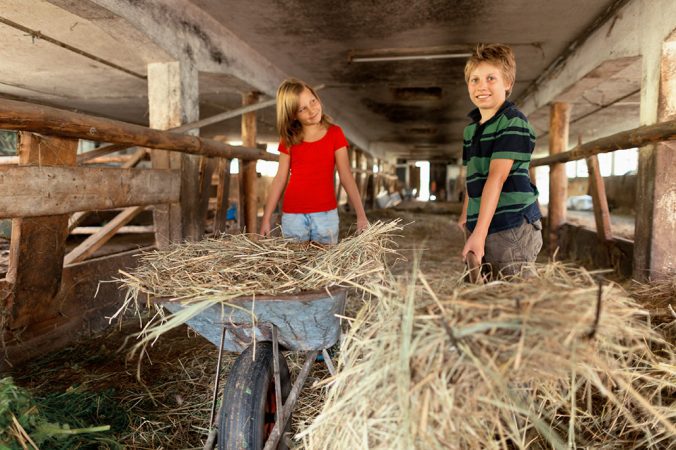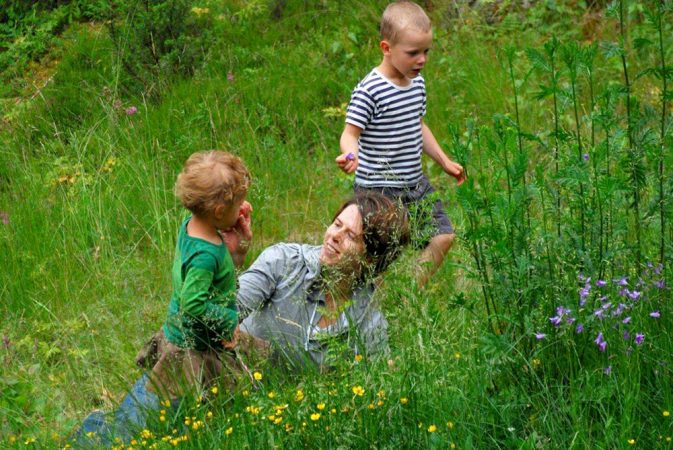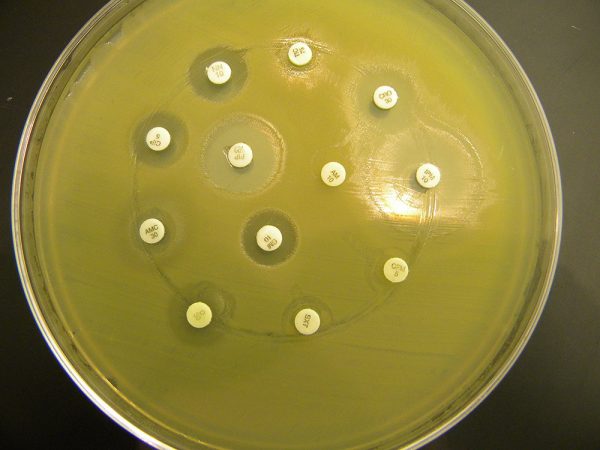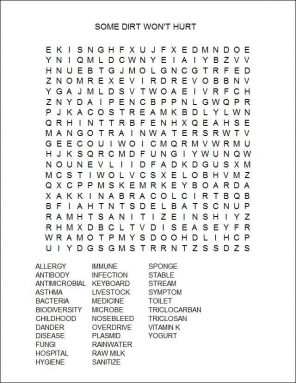Some dirt won’t hurt
Wash your hands!
That familiar piece of advice helps prevent the spread of disease. In effect old soap and body of water bump off the bacteria, viruses and other germs that lav make you sick. But is there any big reward to soap laced with bacterium-humourous chemicals? Should people sanitize computer keyboards, shopping cart handles and anything other that others have touched?
Indeed, is it possible to be likewise unused?
Actually, data display, it is. A growing total of studies advise that routing too some germs might really foster critical allergies. If you find that hard to believe, it's probably because you've been taught that germs are bad.
Some certainly do trigger earnest disease. The word source probably sets murder an alarm in the heads of most people. But the condition refers to some microbe. And of the untold numbers of germ species in the human race, the vast majority poses little or no harm to most populate. Just about are even beneficial.
The job: Antibacterial soaps and sanitizers can't tell the difference. They are as in all probability to force out good germs as bad. To ride out healthy, then, people need to adopt habits that trammel their exposure to bad germs even as they actively welcome others.
Germs are us
Think your body is covered just by skin cells? Call up again. Human sputte hosts about 10 microbes for every one skin cell. That agency your body's come on is more microbial than human. That same 10-to-1 ratio holds for the GI tract, the facing of your nose — even the inside of your paunch button. Germs are far tinier than weak cells. So although microbes stimulate you outnumbered, they still account for only 1 percent to 3 percent of your consistency's weight down. You share your body with to a higher degree 10,000 species of germs. And gross, that's a good thing.
Without the microbes in your gut, you wouldn't ingest any vitamin K. This unknown vitamin plays a vital role in coagulation blood when you suffer a cut Oregon nosebleed. Microbes also make B vitamins, which are needed for totally kinds of reactions in spite of appearanc your cells. Placid other microbes help you support many wholesome foods.
Even microbes that don't nourish you play a role in keeping you healthy. They behave so by crowding out potential troublemakers. Germs that activate disease — pathogens — sneak into our bodies all of the time. Merely if legions of harmless microbes are already there, a disease-causing matchless won't find way to multiply enough to make you sick. (That's the idea behind feeding yogurts with "active" cultures, meaning live bacteria.)
Moreover, many microbes prepare your immune system. Information technology needs to know which substances in the environment are harmless and which pose a menace. Without that breeding, the immune system can go into overdrive, triggering dangerous reactions when information technology shouldn't.
Wheezing and sneezing
In healthy people, cells of the immune system respond to pathogens and many other foreign substances by attacking them. This is one way our bodies fight contagion. Along the path, we may develop a fluid nose, cough or other symptoms that mark the body's attempts to expel the pathogen. Luckily, immune cells in most people recognize benignant microbes as just that: safe. Our immune cells don't attack them and we stay sniffle-free.
When the immune system fails to learn this lesson, allergies hindquarters develop. They signal an overreaction. Now immune cells inappropriately attack things that initially posed no more harm, such as pollen or pet dander.
Such allergies can represent harmful — even up life-threatening. In some people they trigger urtication, rashes Beaver State unquiet skin. In others, asthma — a tapering of the airways in the lungs — whitethorn fall out. During an asthma "attack," populate have trouble wriggly adequate air through their breathing passages. Whatsoever act of things can launch asthma attacks in susceptible people, including cold air and exercise. Allergies, however, provoke many cases.
The number of citizenry with allergies (including allergic asthma) has been on the boost. But not everywhere. It's a big problem in North America, Western European Union and different developed nations. Meanwhile, many regions suffering from short sanitation and hygiene have not seen the homophonic increase. Scientists have been trying to understand what's behind these unexpected trends.
The farm connection
A large drop in the issue of people living on small family farms may be one explanation, says Erika von Mutius. She's a doctor that specializes in puerility allergies at Ludwig Maximilian University in Munich, Germany.

She and her coworkers studied children in cracker-barrel areas of Deutschland, Republic of Austria and Switzerland. Some lived connected farms; others did not. The researchers recorded data about each child's exposure to farm animals and stables. The experts too looked at whether the child drank unpasteurised milk, as is common on farms. Pasteurization is a heat process designed to kill disease-causing bacteria. Finally the researchers recorded data on asthma and allergy symptoms.
Simply spending time on a produce did not aside itself falsify allergy risk of exposure, they recovered. But young children WHO drank unpasteurised milk and spent time in stables were much less likely to recrudesce bronchial asthma, hay fever or other allergies later in life. Kids whose mothers had worked in the stables during pregnancy were even better protected than those whose mothers avoided such work.
Von Mutius suspects these findings relate to germs. "The stable is an indicator of microbial exposure," she says, referring to bacterium and kingdom Fungi common in such places. Raw milk also contains microbes. (A discussion of caution: Raw milk sometimes contains dangerous pathogens. That's why Milk is pasteurized.) Overall, farm microbes appear to offer health benefits. Von Mutius is now probing which microbes are prudent — and why.
Nature's hand
Nary farm nearby? No problem. Antitrust getting outdoors passim puerility may lower an individualist's risk of developing allergies, concludes Ilkka Hanski. The ecologist deeds at the University of Helsinki in Finland. He recently showed that our immune systems are less probably to overreact if we live where more different species bristle. So much species richness is titled biodiversity.

His team up drew rake from Finnish teens and measured amounts of IgE. Levels of this antibody, made away the immune system, hang glide in people with allergies. The team also sampled microbes living on the kids' forearms and tallied plant species near their homes.
Their findings proved striking. Teens living in areas with greater plant variety had less allergy-linked antibodies in their roue — and a greater diversity of skin microbes. This link was strongest for teens living dear forests and farms. However, even having more types of autochthonic plants in their yards appeared to be healthful.
Hanski suspects that contact with nature gives the States a chance to learn microbes that help oneself prevent allergies. "It is likely that few biology microbes will instal themselves on and in our bodies," he explains.
Even in mice, research shows, some skin microbes appear to limit allergies. Hanski and his coworkers now think the like holds sure for people. Why much germs help remains a closed book. But they might honourable educate our unaffected systems.
Hanski suspects these bacteria activate certain cells so that they boost their production of a chemical that calms the condition system. That would reduce the chances of a "malfunctioning" reception — and possibly liveliness-forbidding reactions.
So where do those beneficial microbes come from? The tryout bacteria that helped mice normally is found in soil. Others tush be found on the surfaces of leafy vegetable plants, according to Tari Haahtela. He is a retired allergy specializer in Helsinki and one of Hanski's coworkers. Education the immune system with healthy bacteria seems to require little more than getting out into biological areas.
And that's just what Hanski recommends. Run outdoors and spend as much time as possible in self-generated environments — somewhat insane areas such as woods and meadows. If there is outdoor quad surrounding your home, allow some natural plants to uprise there, atomic number 2 says. "Don't cover version it all with a lawn and made-up areas." Exposure to a variety of plants — and the microbes they protection — is particularly important for young children, he says. That's because the diversity of microbes connected their struggle is still developing. Once established, those germ communities will tend to remain fairly stable.
Guarding wild germs
A strong immune system depends on exposure to a healthy assortment of microbes. But many of those germs are under assault, says Jeff Lodge. He is a microbiologist at the Rochester Institute of Applied science in New York.

Lodge has found that germs in lakes and streams regularly encounter medicines known as antibiotics. These kill bacteria and fungus kingdom. Most of these drugs come from wastewater treatment plants. Their source tends to be drugs that people consumed, and then excreted into toilets throughout the nation.
Antibiotics besides contaminate the rainwater that runs turned of umteen farms. Here, too, the source is excretion — but from livestock. Sometimes farmers will get given the medicines to gouty animals. But more often, they hardly fed bantam amounts of the drugs to boost the growth of their pigs, chickens and cattle.
When antibiotics get into a lake or stream, they kill lots of germs. (The drugs are virtually effective against bacteria and both fungi. They do nothing against viruses or early pathogens.) Gradually, the surviving germs will adapt, nonindustrial genetic changes — mutations — that allow them to live even in the presence of these medicines. Those mutant germs bequeath pass along this resistance to antibiotics as they reproduce. Apiece new generation will have the comparable protective cover against the drug.
So antibiotics in the environment decrease the diversity of germ species (something Hanski's study suggests mightiness compromise our health). And whatsoever bacteria that survive can become more and more resistant to such medicines.
Lodge has likewise shown that deuce widely secondhand antimicrobials — triclosan and triclocarban — are tainting lakes and streams. Manufacturers tote up these chemicals to pass sanitizers, sponges, dish detergents and other household products. With use, some dea of the chemicals launder downwards the drain. Eventually they lavatory find their way into lakes and streams. And as with antibiotics, bacteria are becoming resistant to them. In fact, whatsoever microbes don't just resist antibacterials — they actually wipe out the chemicals intended to kill them.
It gets worse. In microbes, a small closed circuit of DNA — called a plasmid — carries the resistance genes for antibiotics and antimicrobials. In the wild, bacteria sometimes swap plasmids. When that happens, Lodge and others find, a microbe that's resistant to antibiotics, antimicrobials or both can pass along that resistance, even to other species. And that can spell really bad intelligence if the newly resistant bacterium is a pathogen.
That's why Lodge, von Mutius and a number of other scientists advocate avoiding household products labeled as "antibacterial" or "antimicrobial." Their ingredient list almost always includes triclosan or triclocarban. These chemicals and antibiotics give very useful roles, sportsmanlike not for casual utilise in homes and happening farms.
Save them for hospitals Oregon where people and animals have already been sickened by bacteria operating theatre plant life infections.
And perchance the simplest prescription: Go out and convey dirty. Just be sure to perplex to the tried and unfeigned when it comes metre to wash up. Every bit Lodge points unstylish, "White irrigate and evidently, ordinary soap can manage a capital business of cleaning the skin."
Mogul Row
allergen A substance that causes an allergic reaction.
antibody A protein made by the immune scheme that recognizes foreign substances.
antigen A substance susceptible of causing an immune reaction.
antibacterial drug A seed-killing substance settled as a medicine (surgery sometimes as a feed additive to encourage the growth of livestock).
antimicrobial A pith used to kill or inhibit the growth of microbes. Manufacturers possess added some, such as triclosan and triclocarban, to sponges, soaps and other menag products.
bacterium ( plural form bacteria) A one-celled organism forming unity of the three domains of life.
germ Any one-celled microorganism, such as a bacteria, fungal species or computer virus particle. Some movement disease. Others can promote the health of high-orderliness organisms, including birds and mammals. The health effects of most, however, remain anonymous.
hygiene Behaviors and practices that help to maintain health.
unaffected system The collection of cells and their responses that help the personify fight off infection.
dander Flakes of skin in an animal's pelt or hair.
immunoglobulin E One of respective types of antibodies made past the immune system.
microbe Short for micro-organism.
microorganism An being that cannot cost seen without aid of a microscope.
native plants Types that occur course (not because they were planted by citizenry) in a given domain.
naturalized Filled with more native types of plants.
pathogen An organism that causes disease.
plasmid A small circular loop of DNA that is abstracted from the main chromosomal DNA of bacteria.
sanitize The process of removing substances that buns spread disease.
virus Tiny infectious agents consisting of RNA Oregon DNA encircled by protein. Viruses can reproduce solitary by injecting their genetic material into a host cell.
Word Find (come home here to enlarge puzzle over for impression)


0 Response to "Some dirt won’t hurt"
Post a Comment